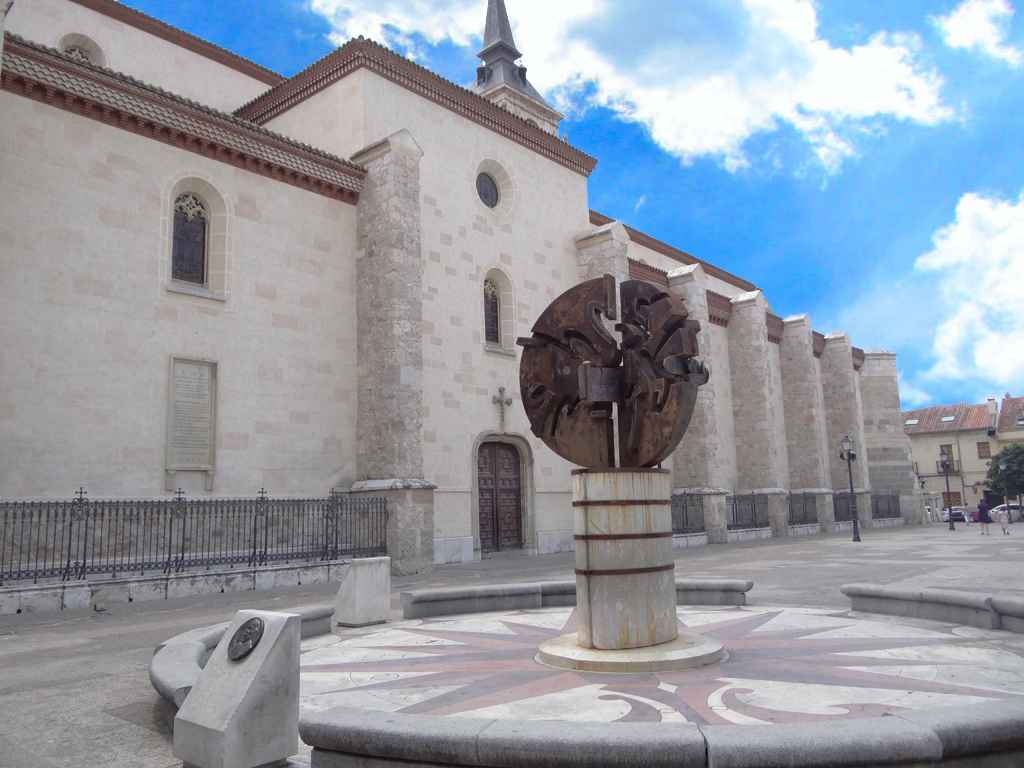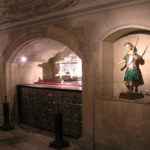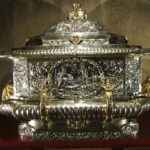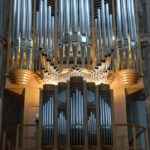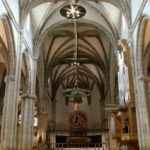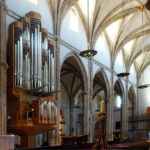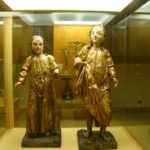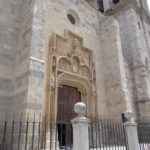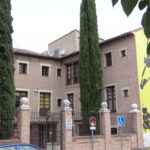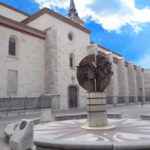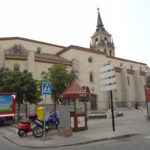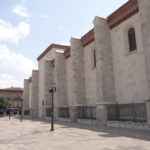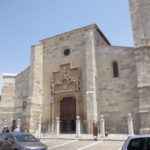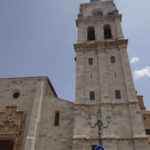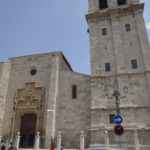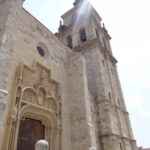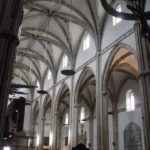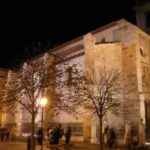Este texto también está disponible en español
The city’s day-to-day life was determined by the Catholic religion, as it also happened in Spain and half Europe during centuries.
In 1995, a millennium and a half after its foundation, Alcalá was turned into a bishopric. In that moment, its Magisterial church—named in that way due to its centenary link with the Cisnerian University—became Magisterial Cathedral, whose tower offers a wonderful bird’s eye view of the city.
Saints Children, Alcalá’s protectors
The existence of the city protector’s— the Saints Children, Justo and Pastor, whose religious commemoration and bank holiday are celebrated every August, 6th— has its origin linked to the cathedral. These two children or teenager were cut the throat of, by Order of the Diocletian emperor, due to their refusal of resigning their faith in Campo Laudable, in the year 305 (fourth century before Christ). Afterwards, the field held the construction of an old church that subsequently gave way to the Magisterial Cathedral that was built upon its remains. The stones where the children were tortured are kept into a Cathedral crypt.
Since that moment, the children were venerated and Alcalá’s population move to the execution emplacement, named the Burgo de Santyuste or Saint Justo to worship them. Sometime after, Alcalá became famous as Alcalá de Santyuste before being known as de Henares.
The growing of the city around the Justo and Pastor’s execution place happened mostly after the city occupation by the Christian troops from the Hispanic Muslims. The conquer, commanded by Bishop don Bernardo, converted the city into Toledo Archbishops’ property. The defeat overcame at the beginning of the twelfth century, when Alcalá received the title of Villa or small town and the right to be governed by its own regional laws.
One of the two Magisterial of Europe
During the period of Arabic domination, the remains of the Saint Children were moved to avoid its desecration to a town situated in a valley, in Huesca, and did not come back until sixteenth century.
The original church was rebuilt by don Rodrigo Jiménez de Rada, who, already in the thirteenth century, impelled the construction of Toledo’s Cathedral. In 1477, the Archbishop Carrillo asked the pope Sixtus IV for the title of collegiate church and achieve so, it means, the building has the same status as a Cathedral even though it had no bishop.
Even though, the temple was knocked down and disappeared in order to build the present cathedral, by order of Cisneros Cardinal, to impel Alcalá, his vital project, its University and the church. In 1497, the cardinal ordered the work to the architects Antón, Enrique Egas, and the Alcalá’s native foreman Pedro Gumiel—faithful servant of the cardinal with its own calle next to the University.
The church style has relevant elements of late Gothic, which makes it the only Gothic cathedral of the Community of Madrid.
Since 1549, the cathedral is also a Magisterial church, the only one in Europe along with that of San Pedro, in Leuven (Belgium). This title means that every priest of the chapter had to be magistri, doctors in Theology by the University founded by Cisneros.
The tower
The tower was built after the temple by the same author of the University façade, Rodrigo Gil de Hontañón. Started in 1527, the tower was not ended until the beginning of the next century. This is one of the few places of height in Alcalá from where you can enjoy the sight of every area of the city and the Henares valley, and in order to see the city with a bird’s eye view, completely panoramic, its visit is a must.
The church undertook a great restoration in the first third of twentieth century and suffered a fire and a plundering during the Spanish Civil War, being restored again after that.
Queens and emperors
In the Magisterial Cathedral church, the infant Catherine of Aragon—who was born in the close Archbishop’s Palace on December, 15th, 1485—was baptized. Afterwards, she would be married with the King Henry VIII of England. Ferdinand of Hapsburg—emperor of Germany after his brother abdication Charles V/Charles I of Spain—was also baptized in the cathedral on March, 18th, 1503.
The Blancafort organ
Besides the temple visit, it is highly recommendable to go through the Cathedral Museum, with artistic and liturgical objects, as well as the Interpretation Center, where you will find a complete exposition about the Magisterial Cathedral meaning and history.
If, during your visit, the mass is celebrated, you can enjoy the wonderful Blancafort organ and many other concerts hold along the year. Enjoy the highly prestigious “Alcalá’s Cathedral” International Organ Festival, annually celebrated since 2007.
Additional information:
Useful information:
Before getting into the building, take the following into account:
- The visit to the temple is not allowed during the liturgical act celebration.
- Visit timetables can suffer modifications depending to the Cathedral liturgical activities.
- Access to the temple will not be allowed to people who do not wear respectful clothing.
- It is asked to be silent during the visit considering the sacred character of the temple.
- It is not allowed to drink or eat within the temple.
- It is not allowed to talk by phone or use laser pointers or amplifier microphones.
- It is allowed to photograph and film the inside of the cathedral unless otherwise specified.
- The cathedral has several alarm systems to protect valuable works.
Opening hours and contact details
Visits
- The cathedral can be visited during opening hours: from 9 a.m. to 13 p.m. and from 17 p.m. to 20:30 p.m. (Sunday and holiday from 10 a.m. to 13:30 p.m. and from 18 p.m. to 20:30 p.m., depending on mass timetables).
- Individual visitors will receive an informative three-page leaflet: 0.50 €.
- Groups visits (more than 10 people) will be leaded by the Cathedral Guide (Community of Madrid Official Guide may guide the groups visit, prior authorization; reservation conditions to be consulted in tel. 667 696 323).
- Groups guided visits at different timetables, prior reservation (tel. 667 696 323).
Ticket prices
- Cathedral and Interpretation Center visit: 3,00 €
- Tower visit: 3,00 €
- Monasterio de San Bernardo visit: 3,00 €
- Cathedra -Tower joint visit: 5 €
- Cathedral-San Bernardo joint visit: 5 €
- Tower-San Bernardo joint visit: 5,00 €
- Cathedral-San Ildefonso joint visit (university): 5 €
Group special conditions to be consulted (tel. 667 696 323).
Information and reservations
- Tel: 91 888 09 30 (general information) and 667 696 323 (reservations).
Access from Madrid
- Renfe Cercanías railroads C-1, C-2 and C7A.
- Bus nº 223 (departure from Avenida de América Interchanger).
Image gallery:
Where is it
Sigue disfrutando de Dream Alcalá:
- Telegram: Recibe nuestras noticias y contenido exclusivo (clic aquí).
- Newsletter: Recibe cada tarde un correo con nuestras últimas noticias (clic aquí).
- YouTube: Suscríbete para ver nuestros mejores vídeos (clic aquí).
 Sé tú el periodista: envíanos tus fotos o noticias a través de Telegram.
Sé tú el periodista: envíanos tus fotos o noticias a través de Telegram.

